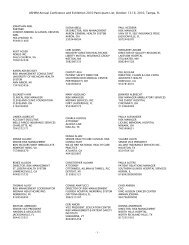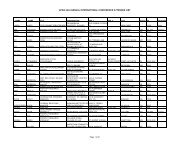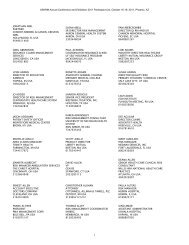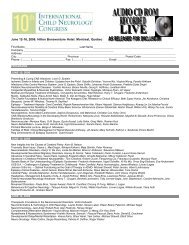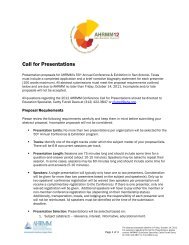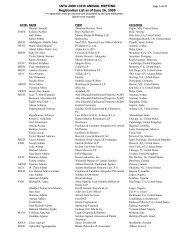learn. connec . advance. - SoftConference.com
learn. connec . advance. - SoftConference.com
learn. connec . advance. - SoftConference.com
Create successful ePaper yourself
Turn your PDF publications into a flip-book with our unique Google optimized e-Paper software.
detailed schedule<br />
Monday, July 21 Monday, July 21<br />
1.3 Tracking the Return on Supply Chain Investments<br />
Finance I<br />
Room: 213<br />
In 2006, Intermountain Healthcare invested over $2M in new supply<br />
chain personnel to reach the goal of delivering $20M in yearly supply<br />
savings for at least four consecutive years. This presentation will<br />
illustrate how the new supply chain organization at Intermountain<br />
Healthcare developed processes, definitions, and reports to deliver on<br />
the expected financial returns. Find out what tools are used to<br />
automate the savings reporting and how the savings are incorporated<br />
into budgets. Included will be examples of individualized supply<br />
savings reports that track clinical and non-clinical savings for several<br />
centralized departments and major divisions including the<br />
Intermountain Medical Group clinics.<br />
Tim Goates<br />
Director, Finance and Information - Supply Chain, Intermountain<br />
Healthcare<br />
Salt Lake City, UT<br />
Mato Taufa<br />
Sr. Analyst, Supply Chain Organization, Intermountain Healthcare<br />
Salt Lake City, UT<br />
1.4 Using RFID & Barcode Systems for Inventory Management<br />
Technology Solutions B I<br />
Room: 214<br />
The Heart Hospital Baylor Plano has taken a unique approach of<br />
leveraging two point-of-use technologies, radio frequency identification<br />
(RFID), and barcode scanning to automate the inventory management<br />
processes within their surgical specialty areas. By aligning business<br />
needs with technical capabilities, the organization has deployed a<br />
single, integrated solution that manages inventory with the two<br />
automated approaches. This presentation will explore the attributes of<br />
each automation technology and discuss its desired business needs. In<br />
addition, the key lessons <strong>learn</strong>ed in the installation process and in the<br />
operational experience of using this hybrid technology approach will<br />
be reviewed.<br />
Brad Morgan<br />
Director of Material Management, The Heart Hospital Baylor Plano<br />
Plano, TX<br />
1.5 Environmental Purchasing to Improve Performance<br />
Purchasing I<br />
Room: 211<br />
This interactive session will provide information and case studies<br />
covering how material managers can easily integrate environmental<br />
purchasing practices into their processes to save money and improve<br />
their customers’ or facilities’ environmental bottom lines. Topics<br />
covered will include getting your suppliers to track your environmental<br />
purchasing progress for you; spotting misleading vendor environmental<br />
claims; available resources to help you evaluate and specify<br />
environmentally preferable products (EPPs); building vendor<br />
partnerships to increase your use of EPPs and decrease your use of<br />
products containing toxic and untested chemicals; key environmentally<br />
preferable products available at equivalent price points; and<br />
successfully working with product users.<br />
Lara Sutherland<br />
Director of Environmental Purchasing Consulting, Practice GreenHealth<br />
Denver, CO<br />
1.6 Value Analysis: Hospital & Clinics Case Study<br />
Strategic Planning I<br />
Room: 207<br />
Stanford Hospital & Clinics <strong>com</strong>mitted to redesign its Value Analysis<br />
program to achieve higher levels of results in supplies and services<br />
expense reduction. The objectives were to utilize a more structured and<br />
disciplined approach for decision-making and to facilitate a culture<br />
change towards user-department ownership. The savings target was<br />
$14.2 million. This session will review a case study that includes: the<br />
design methodology for the Value Analysis program; ROI development<br />
for additional resources and support; standardized protocols for<br />
identifying opportunities, analysis, evaluation, selection, sourcing, and<br />
contracting; end-user and key stakeholder participation (physicians as<br />
needed); selection of highest-valued supplies and services;<br />
<strong>com</strong>munications channels; protocols for managing effective<br />
implementation and contract management; and establishing reporting<br />
tools and executive dashboards.<br />
Rex Fieck<br />
Director, Materials Management, Stanford Hospital & Clinics<br />
Stanford, CA<br />
Scott Watkins<br />
Vice President, Supply Chain Performance, OMSolutions<br />
Fillmore, CA<br />
22 23



